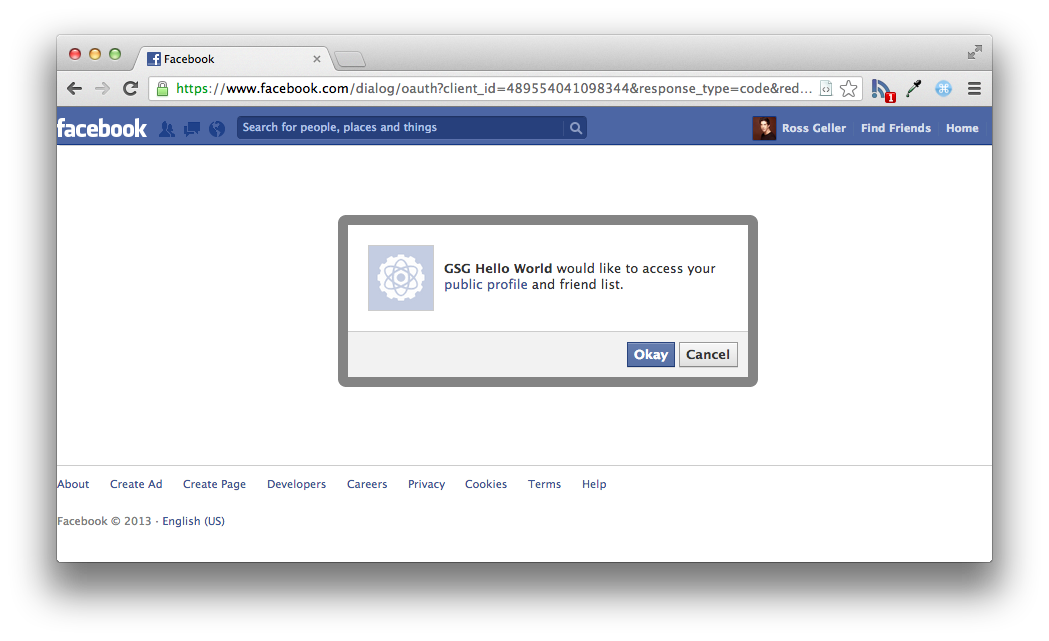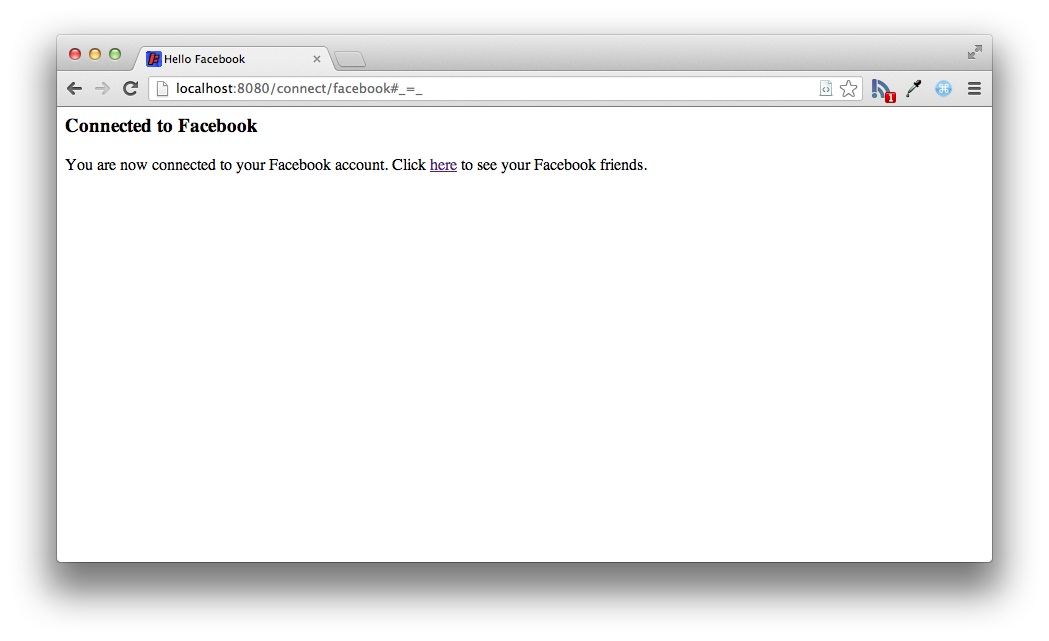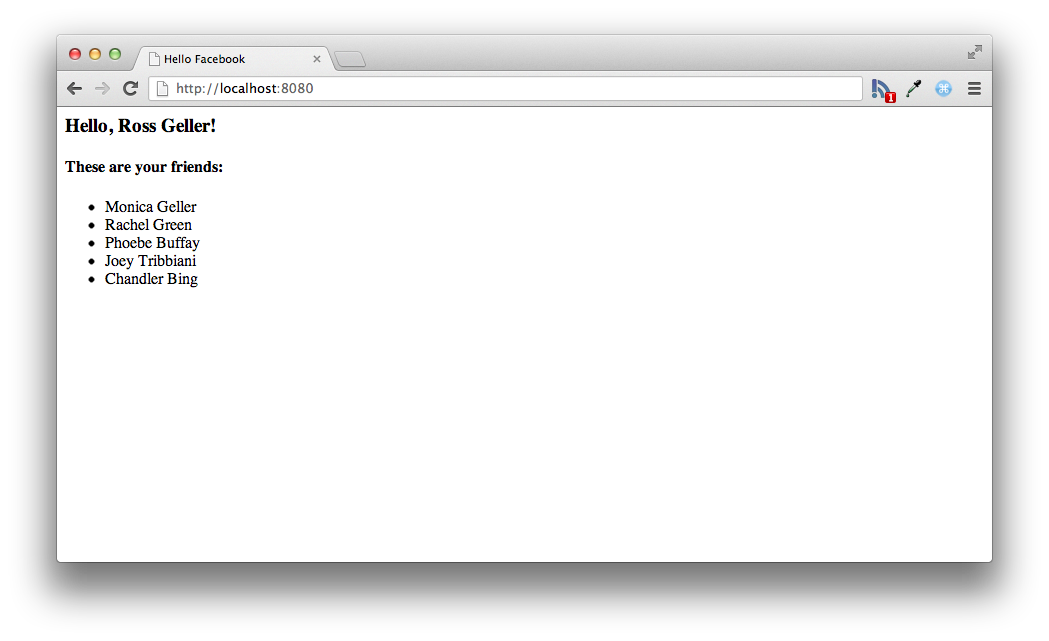| tags | projects | |
|---|---|---|
|
This guide walks you through the process of creating a simple web application that accesses Facebook data.
What you’ll build
You’ll build a web application that accesses data from a Facebook user profile, as well as profile data from that user’s Facebook friends.
What you’ll need
Set up the project
https://raw.github.com/spring-guides/getting-started-macros/master/create_both_builds.adoc
build.gradle
link:initial/build.gradle[]Enable Facebook
Before you can fetch a user’s data from Facebook, you need to set up the Spring configuration. Here’s a configuration class that contains what you need to enable Facebook in your application:
src/main/java/hello/FacebookConfig.java
link:complete/src/main/java/hello/FacebookConfig.java[]Because the application will be accessing Facebook data, FacebookConfig is annotated with @EnableFacebook. Notice that, as shown here, the appId and appSecret attributes have fake values. For the code to work, obtain a real application ID and secret and replace these fake values with the real values given to you by Facebook.
After a user authorizes your application to access their Facebook data, Spring Social creates a connection. That connection will need to be saved in a connection repository for long-term use.
For the purposes of testing and for small sample applications, such as the one in this guide, an in-memory connection repository is sufficient. Notice that FacebookConfig is annotated with @EnableInMemoryConnectionRepository.
For real applications, you need to select a more persistent option. You can use @EnableJdbcConnectionRepository to persist connections to a relational database.
Within the FacebookConfig’s body, two beans are declared: `ConnectController and UserIdSource.
Obtaining user authorization from Facebook involves a "dance" of redirects between the application and Facebook. This process is formally known as OAuth's Resource Owner Authorization. Don’t worry if you don’t know much about OAuth. Spring Social’s ConnectController takes care of the OAuth dance for you.
Notice that ConnectController is created by injecting a ConnectionFactoryLocator and a ConnectionRepository via the constructor. You won’t need to explicitly declare these beans, however. The @EnableFacebook annotation makes sure that a ConnectionFactoryLocator bean is created, and the @EnableInMemoryConnectionRepository annotation creates an in-memory implementation of ConnectionRepository.
Connections represent a three-way agreement among a user, an application, and an API provider such as Facebook. Facebook and the application itself are readily identifiable. You identify the current user with the UserIdSource bean.
Here, the UserIdSource bean is defined by an inner-class that always returns "testuser" as the user ID. The sample application has only one user. In a real application, you probably want to create an implementation of UserIdSource that determines the user ID from the currently authenticated user, perhaps by consulting with an Authentication obtained from Spring Security’s SecurityContext).
Create connection status views
Although much of what ConnectController does involves redirecting to Facebook and handling a redirect from Facebook, it also shows connection status when a GET request to /connect is made. It defers to a view named connect/{providerId}Connect when no existing connection is available and to connect/{providerId}Connected when a connection exists for the provider. In this case, provider ID is "facebook".
ConnectController does not define its own connection views, so you need to create them. First, here’s a Thymeleaf view to be shown when no connection to Facebook exists:
src/main/resources/templates/connect/facebookConnect.html
link:complete/src/main/resources/templates/connect/facebookConnect.html[]The form on this view will POST to /connect/facebook, which is handled by ConnectController and will kick off the OAuth authorization code flow.
Here’s the view to be displayed when a connection exists:
src/main/resources/templates/connect/facebookConnected.html
link:complete/src/main/resources/templates/connect/facebookConnected.html[]Fetch Facebook data
With Facebook configured in your application, you now can write a Spring MVC controller that fetches data for the user who authorized the application and presents it in the browser. HelloController is just such a controller:
src/main/java/hello/HelloController.java
link:complete/src/main/java/hello/HelloController.java[]HelloController is created by injecting a Facebook object into its constructor. The Facebook object is a reference to Spring Social’s Facebook API binding.
The helloFacebook() method is annotated with @RequestMapping to indicate that it should handle GET requests for the root path (/). The first thing the method does is check whether the user has authorized the application to access the user’s Facebook data. If not, the user is redirected to ConnectController with the option to kick off the authorization process.
If the user has authorized the application to access Facebook data, the application fetches the user’s profile as well as profile data for the user’s friends that is visible to that user. The data is placed into the model to be displayed by the view identified as "hello".
Speaking of the "hello" view, here it is as a Thymeleaf template:
src/main/resources/templates/hello.html
link:complete/src/main/resources/templates/hello.html[]Make the application executable
Although it is possible to package this service as a traditional web application archive or WAR file for deployment to an external application server, the simpler approach demonstrated below creates a standalone application. You package everything in a single, executable JAR file, driven by a good old Java main() method. And along the way, you use Spring’s support for embedding the Tomcat servlet container as the HTTP runtime, instead of deploying to an external instance.
src/main/java/hello/Application.java
link:complete/src/main/java/hello/Application.java[]The main() method defers to the SpringApplication helper class, providing Application.class as an argument to its run() method. This tells Spring to read the annotation metadata from Application and to manage it as a component in the Spring application context.
The @ComponentScan annotation tells Spring to search recursively through the hello package and its children for classes marked directly or indirectly with Spring’s @Component annotation. This directive ensures that Spring finds and registers the GreetingController, because it is marked with @Controller, which in turn is a kind of @Component annotation.
The @Import annotation tells Spring to import additional Java configuration. Here it is asking Spring to import the FacebookConfig class where you enabled Facebook in your application.
The @EnableAutoConfiguration annotation switches on reasonable default behaviors based on the content of your classpath. For example, because the application depends on the embeddable version of Tomcat (tomcat-embed-core.jar), a Tomcat server is set up and configured with reasonable defaults on your behalf. And because the application also depends on Spring MVC (spring-webmvc.jar), a Spring MVC DispatcherServlet is configured and registered for you — no web.xml necessary! Auto-configuration is a powerful, flexible mechanism. See the API documentation for further details.
https://raw.github.com/spring-guides/getting-started-macros/master/build_an_executable_jar_subhead.adoc https://raw.github.com/spring-guides/getting-started-macros/master/build_an_executable_jar_with_both.adoc
... app starts up ...
Once the application starts up, point your web browser to http://localhost:8080. No connection is established yet, so this screen prompts you to connect with Facebook:
When you click the Connect to Facebook button, the browser is redirected to Facebook for authorization:
Click "Okay" to grant permission for the sample application to access your public profile and list of friends.
Once permission is granted, Facebook redirects the browser back to the application. A connection is created and stored in the connection repository. You should see this page indicating that a connection was successful:
Click the link on the connection status page, and you are taken to the home page. This time, now that a connection has been created, you see your name on Facebook and a list of your friends. Although only names are shown here, the application retrieves profile data for the user and for the user’s friends. What is in the friends' profile data depends on the security settings for each individual friend, ranging from public data only to the complete profile.
Summary
Congratulations! You have developed a simple web application that obtains user authorization to fetch data from Facebook. The application connects the user to Facebook through Spring Social, retrieves data from the user’s Facebook profile, and also fetches profile data from the user’s Facebook friends.



